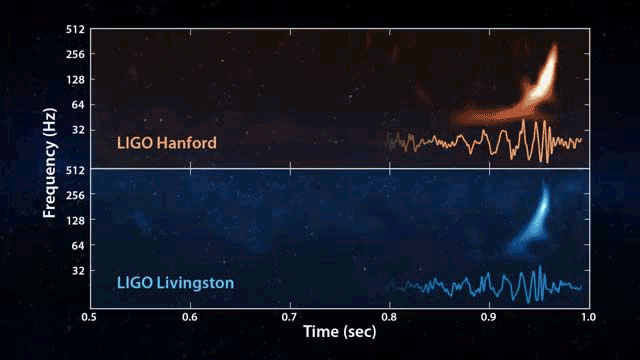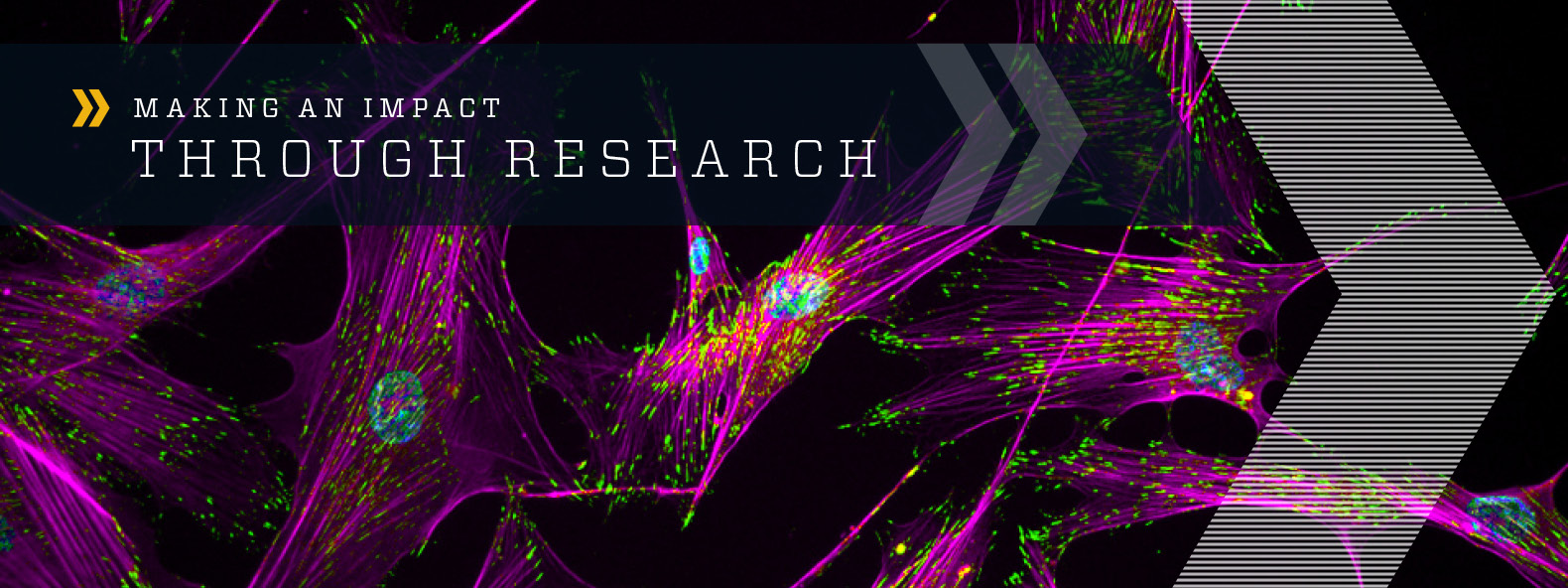
Annual Report Navigation
Making an Impact through Research
A research enterprise driven by a determination to improve human life while creating value and opportunity is a prominent element of Georgia Tech’s culture. Our faculty and students use their renowned research expertise to create the next solutions for the world’s toughest challenges.
Health and Medicine
Marcus Center Advancing Cell-based Therapies
A $15.7 million grant from the Atlanta-based Marcus Foundation helped launch a new Georgia Tech research center that is developing processes and techniques for ensuring the consistent, low-cost, large-scale manufacture of high-quality living cells used in cell-based therapies. The therapies will be used for a variety of disorders such as cancer, lung fibrosis, autism, neuro-degenerative diseases, autoimmune disorders, and spinal-cord injury — as well as in regenerative medicine.
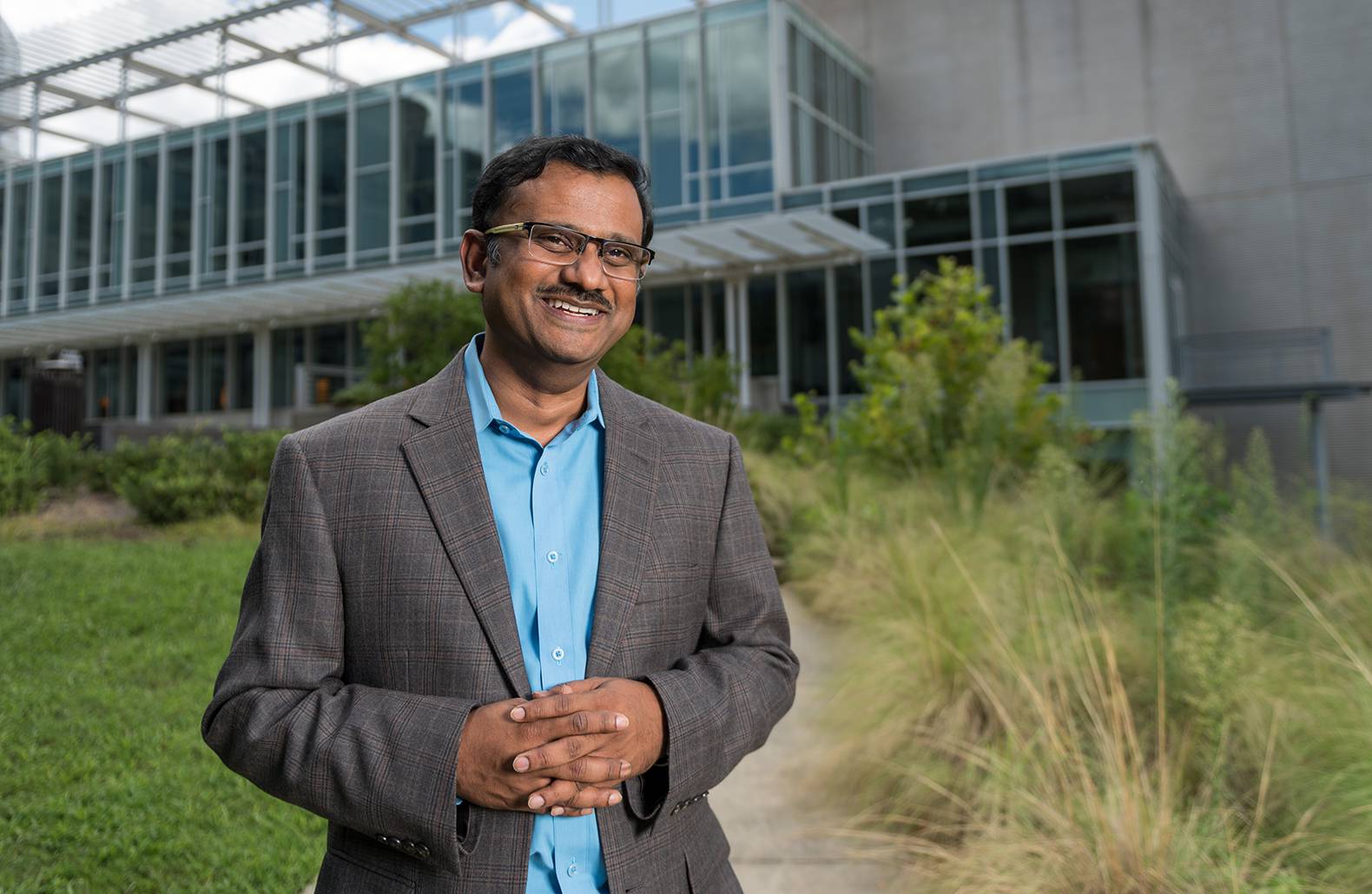

Adult human fibroblast cells like these are converted to human-induced pluripotent stem cells through a reprogramming process during which restructuring of the adhesion proteins (shown in green) takes place. (Image courtesy of Ankur Singh)
The work of the new Marcus Center for Therapeutic Cell Characterization and Manufacturing will help provide standardized production and quality testing for these living cells, which have great therapeutic potential. Standardized manufacturing techniques already exist for drug-based pharmaceuticals; the new center will help provide similar methods and standards for manufacturing therapeutic cells.
“The aspirin you buy today from one pharmacy is essentially the same as the aspirin you buy from another pharmacy, but cell-based therapies may have different efficacy depending on the source and manufacturing processes,” said Krishnendu Roy, Robert A. Milton Chair and professor in the Coulter Department of Biomedical Engineering. “There are established ways to quickly assess the efficacy and safety of small-molecule drugs that are acceptable around the world. We want to develop and establish similar processes for therapeutic cell manufacturing.”
NIH Award Funds Pulmonary Fibrosis Research
A $3.5-million, five-year Transformative Research Award from the National Institutes of Health (NIH) will support research into new approaches for tracking and treating pulmonary fibrosis, a disease that claims 40,000 lives per year.
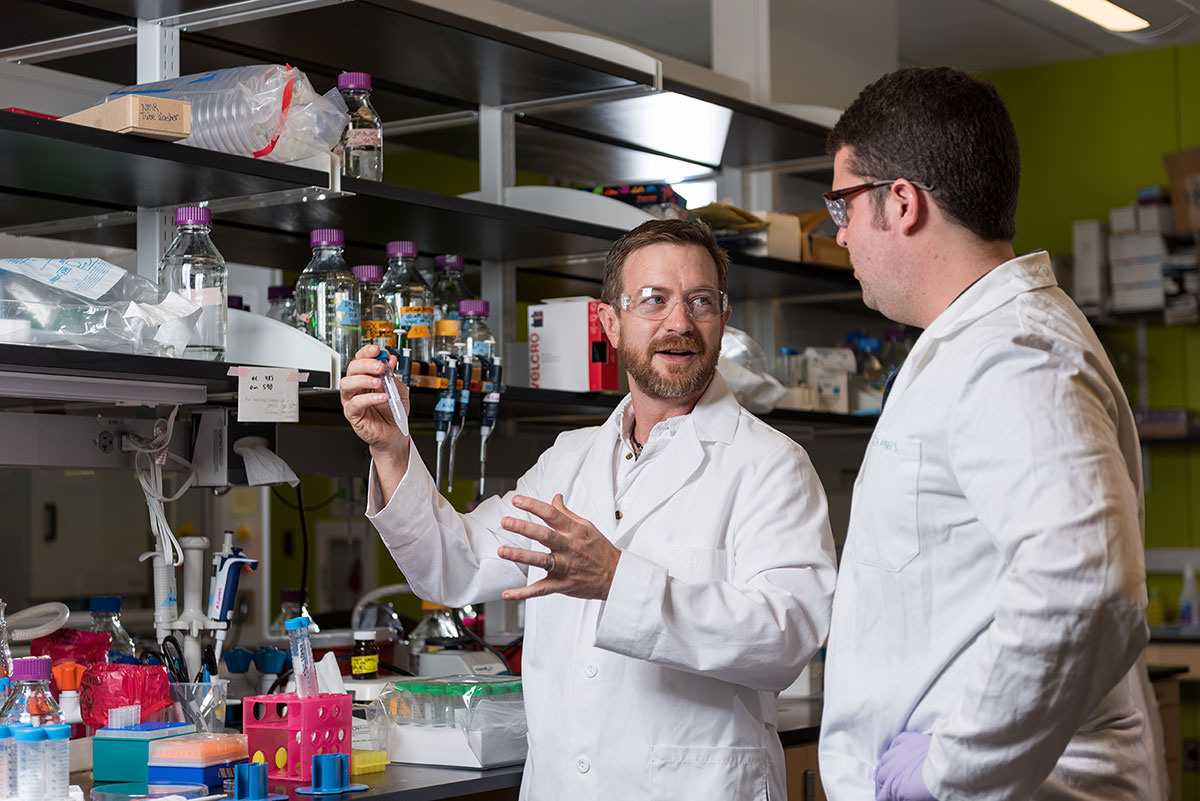
Thomas Barker (left) and Dwight Chambers (right) in the Barker Lab in the Engineered Biosystems Building (EBB).
The grant was made to Thomas Barker, an associate professor in the Coulter Department of Biomedical Engineering.
Pulmonary fibrosis is an incurable disease in which the uncontrolled growth of scar tissue severely damages the ability of the lungs to bring oxygen into the body. Researchers plan to hijack the cellular mechanisms that normally worsen the disease, causing them to instead produce a chemical compound that would reduce the cross-linking associated with the fibrosis.
“Fibrosis is wound healing that just won’t quit. Cells continually repair the same tissue over and over again until you get this dense, biophysically restricted scar tissue.”
Thomas Barker
“Fibrosis is wound healing that just won’t quit,” explained Barker. “Cells continually repair the same tissue over and over again until you get this dense, biophysically restricted scar tissue. That scar tissue not only impairs the ability to bring in oxygen, but at the cellular level that increased stiffness also provides a dominant signal that continues to drive this aberrant process.”
Barker wants to tap into the signaling that occurs between cells and their environment to co-opt the cellular response to stiffness of the extracellular matrix. Instead of creating more scar, the cells would respond by releasing a protease to dissolve some of the crosslinks that create the stiffness.
Cybersecurity
Grant Aims to Upgrade Data Transfer Security
Researchers from the College of Computing were awarded $4.2 million from the Defense Advanced Research Projects Agency and the Air Force Research Laboratory to improve how data is tracked between computers, internet hosts, and browsers for better cybersecurity.
The four-year project, titled “THEIA” after the Greek goddess of shining light, attempts to shed light on exactly where data moves as it is routed from one internet host to another and whether any malicious code, for example, is attached to data during transfer.
“The project has wide implications for any industry and anyone who needs to send secure information, make sure it is not manipulated during transfer, and that it arrives securely intact — but especially for those banking, shopping, or trading online,” said Wenke Lee, primary investigator and professor in the College of Computing. “If we have the ability to fully track how data is processed until it reaches the intended recipient, then we can better detect and stop advanced persistent threats.”
THEIA will track and record information at three layers: user interaction with a program, program processing of data input, and program and network interactions with an operating system. THEIA will monitor secure data flow from user to program, from program to file system storage, and storage to network output, and back again.
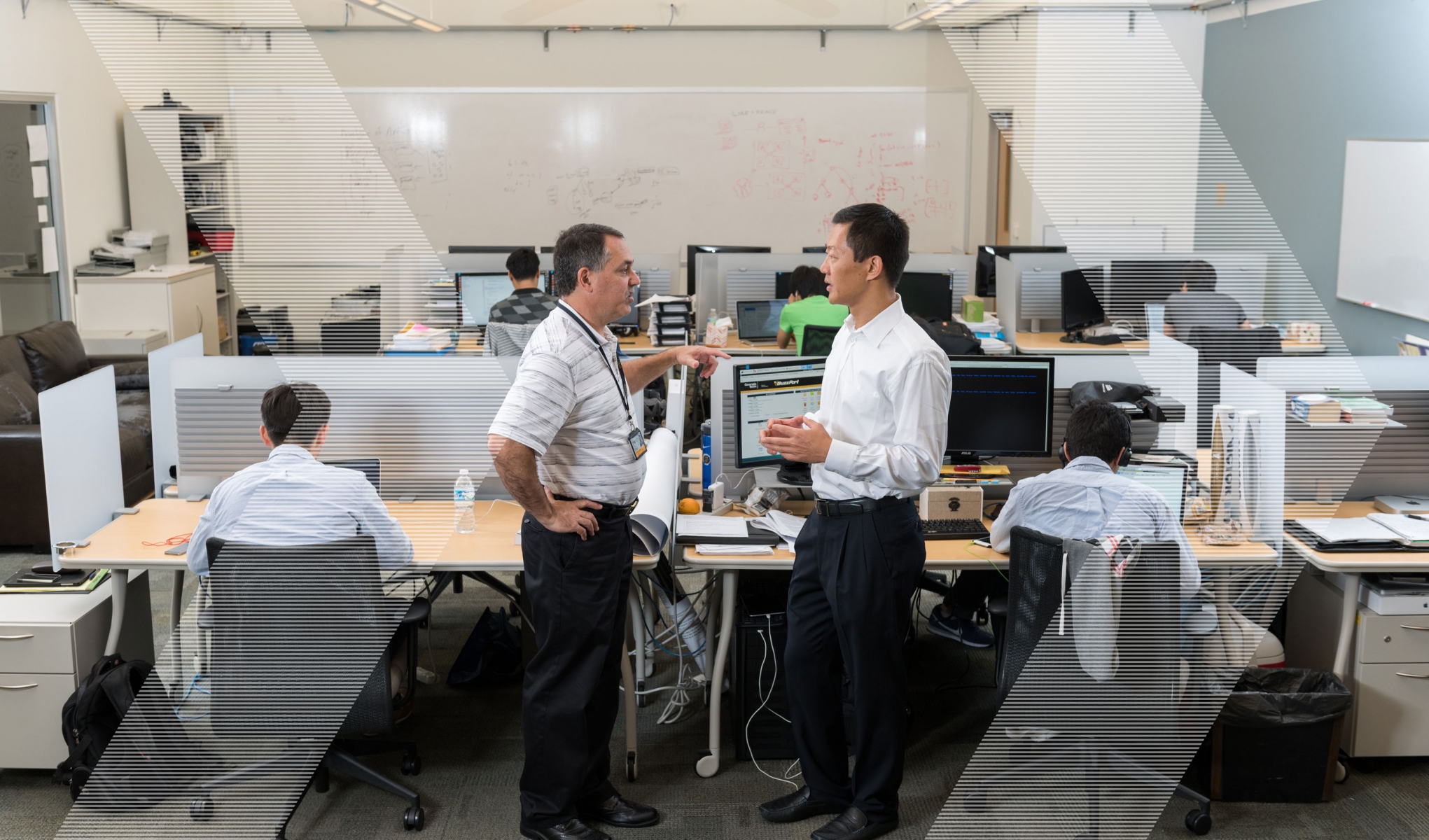
Francis "Bo" Rotoloni and Wenke Lee of the Institute for Information Security and Privacy.
Institute for Information Security & Privacy Established
In response to widespread and persistent cybersecurity threats to businesses, government, and individuals, Georgia Tech has formed a new interdisciplinary research collaborative — the Institute for Information Security & Privacy (IISP).
The IISP aligns the expertise of more than 460 researchers and nine labs across four colleges and the Georgia Tech Research Institute (GTRI) to form a single gateway to all cybersecurity efforts. Its purpose is to connect academia, industry, and government to seamlessly develop vital solutions for national security, economic continuity, and individual safety.
It is led by co-directors Bo Rotoloni, a principal research engineer at GTRI, and Wenke Lee, a professor in the College of Computing and one of the world’s most prolific cybersecurity researchers. Associate directors include experts in law, business management, computing, and defense.
“Under the IISP, we expect to double our current cybersecurity research activity to move more research out to the marketplace, to develop new continuing education programs for professionals, and to broaden the cybersecurity curriculum so it is taught across more degree fields at Georgia Tech,” said Rotoloni. “We want to be a catalyst for an information security industry in Georgia that is already attracting national attention and embolden it through joint research projects with companies of all sizes and critical government agencies.
Sustainability/Climate Change
NSF Research Network to Build Cities of the Future
A new National Science Foundation-funded research network is connecting scientists at nine universities with infrastructure groups, public policy experts, and industry partners to reimagine cities. Georgia Tech is an anchor of the $12 million network, led by the University of Minnesota; Professor Ted Russell in Tech’s School of Civil and Environmental Engineering serves as a co-director.
“We’re looking at real-life cities and figuring out how to make these cities work better and how to help cities evolve.”
Ted Russell
“We’re bringing some very different communities together more than past projects have done,” Russell said. “We are getting the engineering community, the health community, the atmospheric sciences community, the economics communities, and the policy communities in the same virtual room to look to the future. We’re looking at real-life cities and figuring out how to make these cities work better and how to help cities evolve.”
The research network will use cities across the United States (including Atlanta) and in India as “test beds” for its work, a unique approach that Russell said means the outcome of the network’s studies will have significant impact. The project, called a Sustainability Research Network, will run for four years.
“Real success at the end of those four years would be one or more cities — having worked with us from the beginning — taking actions that will lead to improving the livability of their city,” Russell said. “That could come in multiple ways: improved transit options, improved plans for water usage, effective urban farming, or strategies to improve air quality that they’ve actually implemented and to inform their citizenry of how to reduce their exposures to harmful chemicals and lead more healthy lives.”
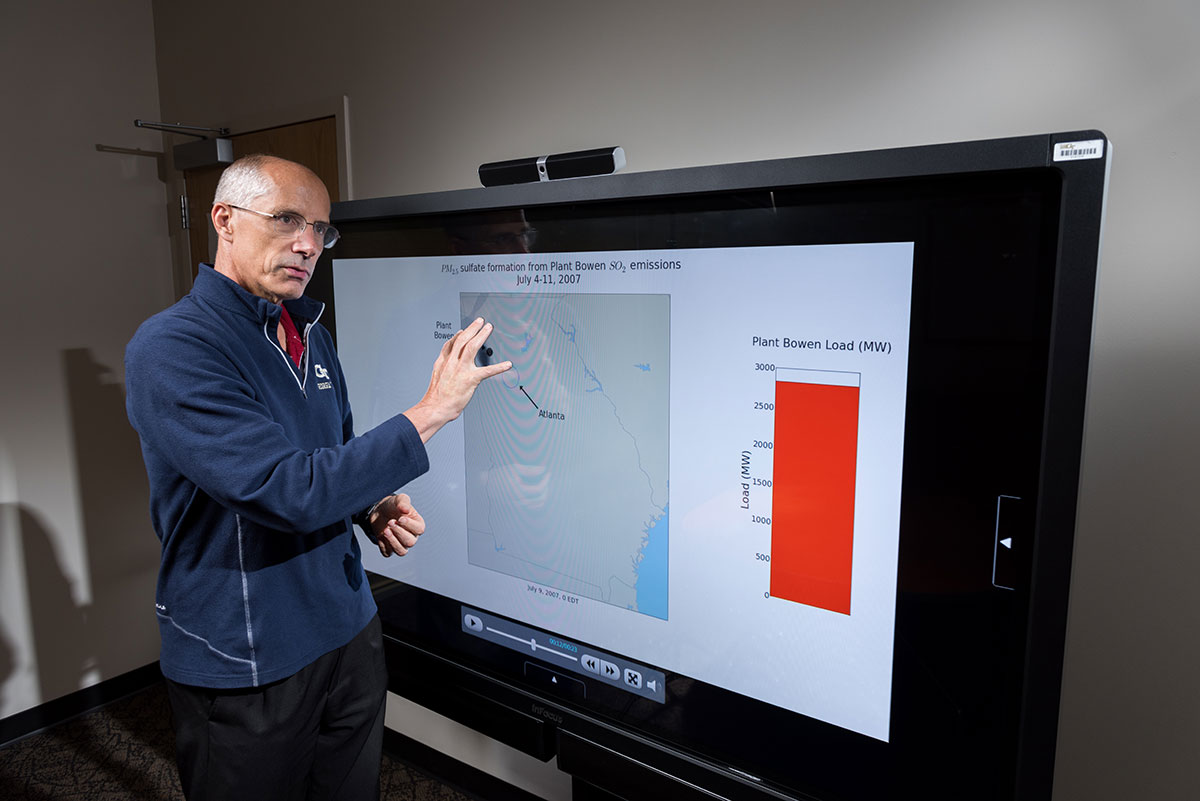
Professor Ted Russell with an air quality prediction model showing how the impacts from generating plant emissions vary over time.
Study Predicts Climate Change Sooner than Expected
For the 70,000 residents of the Marshall Islands, global climate change isn’t a theoretical concern with far-off potential consequences. The island nation is at no point more than six feet above the Pacific Ocean, and because sea levels are already rising, the nation’s leaders have made plans to move to higher ground in Fiji.
Only immediate and aggressive efforts to mitigate the effects of climate change can head off accelerating near-term impacts such as those in the Marshall Islands, argues a paper co-authored by an Ivan Allen College of Liberal Arts faculty member.
“Our argument is that if you want to do something, you’d better do something now because over time, you are going to lose the ability to have an impact,” said Juan Moreno-Cruz, an assistant professor in the School of Economics. “If we delay action on climate change, the likelihood of doing something will be reduced because the damages will be accelerating. The incentives to address it are going to disappear as more damage occurs.”
In addition to Moreno-Cruz, the paper’s co-authors include researchers from Stanford University and the Pottsdam Institute of Climate Impact Research.
“We have a relatively small window of opportunity in terms of economic incentives underlying the climate science,” Moreno-Cruz said. “Once we pass a certain threshold, we won’t be able to go back because we will lose the incentives to do so.”

Rising sea levels are threatening the Marshall Islands, an extremely low-lying island nation. (Photo courtesy Google Earth.)
Robotics/Artificial Intelligence
New Robotarium Will Provide Remote Access to Robots
Georgia Tech is building a new lab that will allow roboticists from around the country to conduct experiments remotely. Researchers from other universities, as well as middle and high school students, will schedule experiments, upload their own programming code, watch the robots in real-time via streamed video feeds, and receive scientific data demonstrating the results.
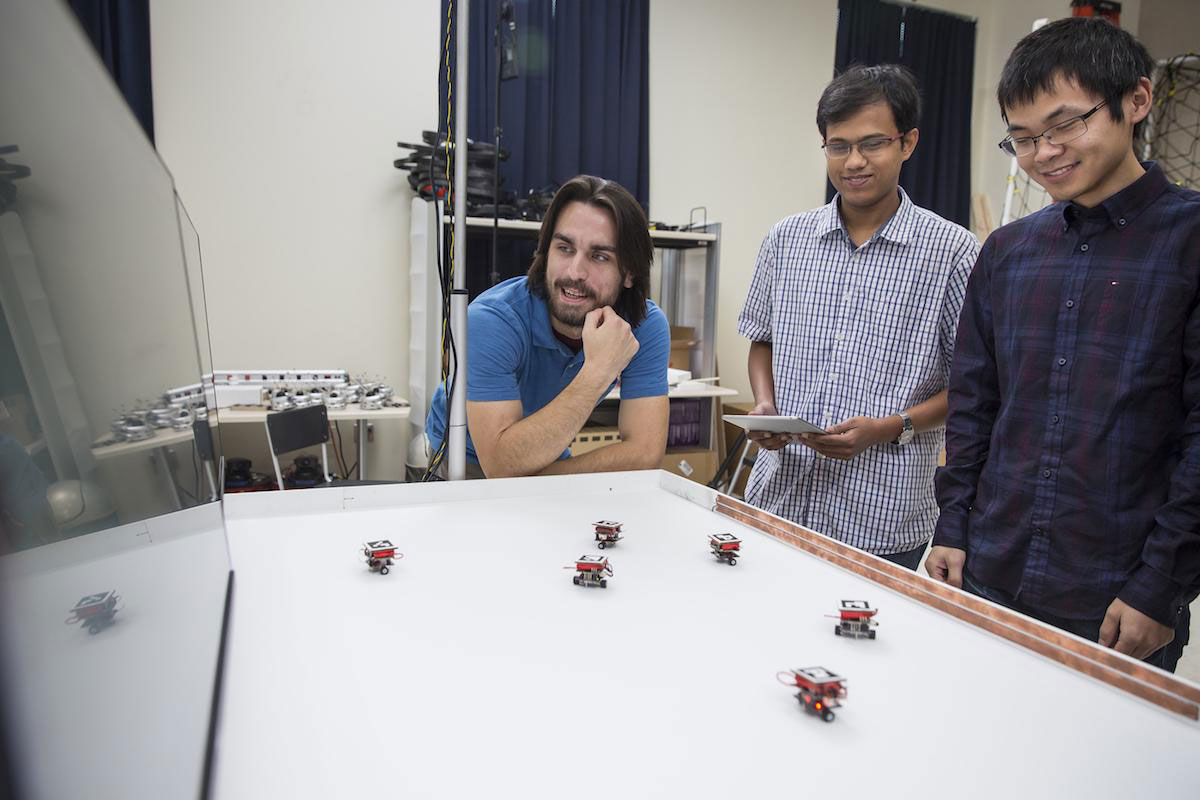
Graduate students Matt Hale, Siddharth Mayya, and Li Wang use the mini-version of the Robotarium in a test session. (Photo by Rafterman Photography.)
The “robotarium” is expected to house up to 100 ground and aerial swarm robots. No other university has a similar facility.
“Building and maintaining a world-class, multi-robot lab is too expensive for a large number of roboticists and budding roboticists. This creates a steep barrier to entry into our field,” said Magnus Egerstedt, executive director of the Institute for Robotics and Intelligent Machines and Schlumberger Professor in the School of Electrical and Computer Engineering. “We need to provide more access to more people in order to continue creating robot-assisted technologies. The robotarium will allow that.”
“We need to provide more access to more people in order to continue creating robot-assisted technologies. The robotarium will allow that.”
Magnus Egerstedt
Egerstedt will lead the project, which includes several Georgia Tech faculty members who will also have access to the facility for their own multidisciplinary experiments and curriculum. The team has already created a mini-version of the robotarium. Graduate students used it to complete their robotics projects. Researchers from the University of California, San Diego, successfully uploaded code during a test session.
The National Science Foundation is helping to fund the project with two grants totaling $2.5 million. The robotarium is expected to be fully operational in 2017.
Using Stories to Teach Human Values to Robots
The rapid rise of artificial intelligence (AI) has raised fears about whether robots could act unethically or choose to harm humans. Some are calling for bans on robotics research; others are calling for more research to understand how AI might be constrained. But how can robots learn ethical behavior if there is no “user manual” for being human?
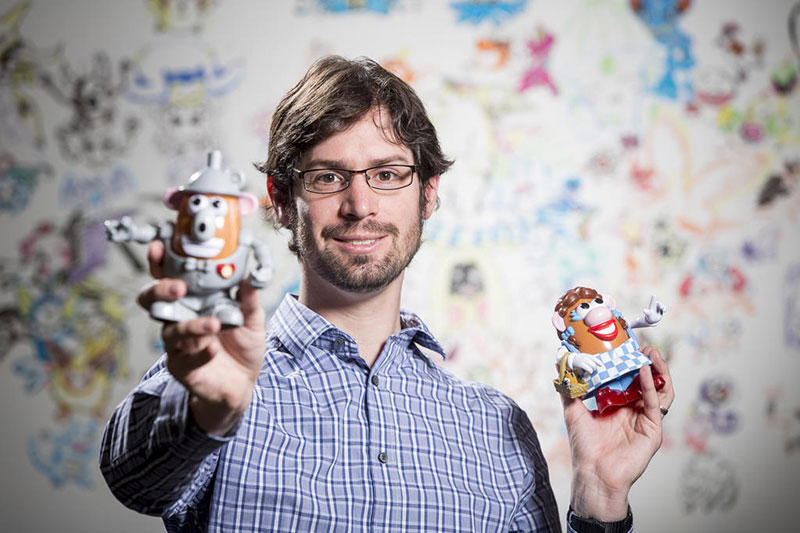
Mark Riedl is associate professor in the School of Interactive Computing at Georgia Tech and director of the Entertainment Intelligence Lab.
Researchers Mark Riedl and Brent Harrison in the School of Interactive Computing believe the answer lies in “Quixote,” which teaches “value alignment” to robots by training them to read stories, learn acceptable sequences of events, and understand successful ways to behave in human societies.
“The collected stories of different cultures teach children how to behave in socially acceptable ways with examples of proper and improper behavior in fables, novels, and other literature,” said Riedl, associate professor and director of the Entertainment Intelligence Lab. “We believe story comprehension in robots can eliminate psychotic-appearing behavior and reinforce choices that won’t harm humans and still achieve the intended purpose.”
Quixote is a technique for aligning an AI’s goals with human values by placing rewards on socially appropriate behavior. The Quixote technique works best for robots that have a limited purpose but need to interact with humans to achieve it, and it is a primitive first step toward general moral reasoning in AI, Riedl said.
“We believe that AI has to be enculturated to adopt the values of a particular society, and in doing so, it will strive to avoid unacceptable behavior.”
Data Analytics
Diamond Eye Provides Real-time, Streaming Data Science
A new analytics framework might soon help businesses monitor massive amounts of data in a user-friendly way.
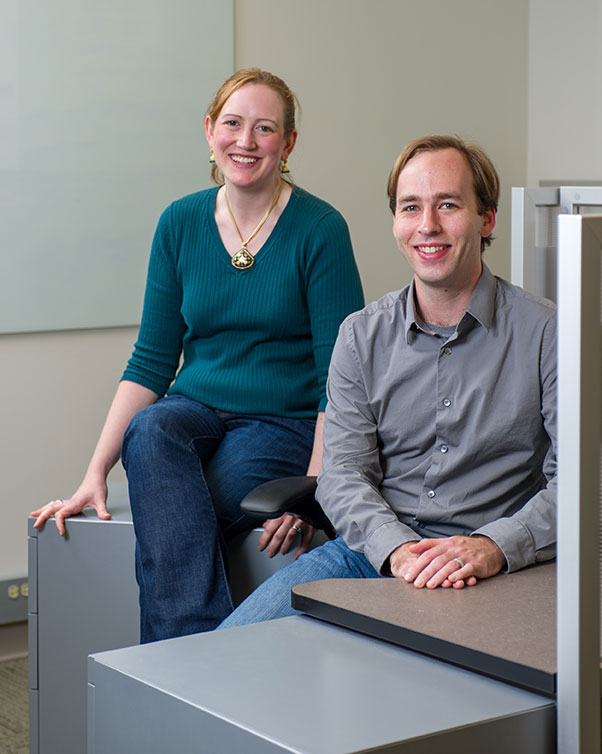
Georgia Tech Research Institue (GTRI) researchers Amy Sharma and David Ediger, creators of Diamond Eye.
Developed by the Georgia Tech Research Institute (GTRI), Diamond Eye is a platform for one-stop data analytics. Before creating Diamond Eye, GTRI researchers had built a series of analytics tools for individual customers. But because they were developed for specific applications, these tools were not designed to be used beyond the original goals and customers.
Diamond Eye takes advantage of the expertise developed for these projects. The platform enables data ingestion, processing, and visualization in a single package, and is able to adapt to new data sources, new analytics, or new visualizations.
“Before Diamond Eye, it was difficult to share analytics because only the developer who had created it had the access or the know-how to use it,” said Amy Sharma, a research engineer at GTRI. “With this new framework, anyone can utilize the analytics and any developer can add new data, analytics, or visualizations.”
The system was designed to help users answer historical and real-time questions with their data. It can also provide situational and predictive results, using information about the past to help predict future conditions.
What's next? ![]() Planting the Seeds of Economic Growth
Planting the Seeds of Economic Growth
Annual Report Navigation
(text and background only visible when logged in)

